#Environmental Cleanup
Explore tagged Tumblr posts
Text



These guys get it
14 notes
·
View notes
Text
Alberta's auditor general says $125 million of federal funding earmarked for the cleanup of inactive oil and gas wells in the province went unspent and remains in limbo. The finding is among several concerns about environmental regulation and management flagged by Auditor General Doug Wylie in a 228-page report released Thursday. The auditor general's team said that last they heard, the province and the federal government had yet to agree on whether Alberta could give the remaining money to another agency to clean up more environmental liabilities.
Continue Reading
Tagging @abpoli @politicsofcanada
#cdnpoli#canada#canadian politics#canadian news#oil industry#alberta#oil and natural gas#environmental justice#environmental cleanup
41 notes
·
View notes
Text



We really forgot the whole don't shit in your own nest thing, didn't we? 😡
#valdes peninsula#chubut#patagonia#argentina#circumnavigation#sailing#foundation#environmental cleanup#nature
9 notes
·
View notes
Text

Prius Behavior (2023) Edited traditional art after scan and edited photo of EPA cleanup site in New Jersey in the negative space.
#art#cars#prius#gen2 prius#gen 2 prius#gen 2 prius is the greatest car in the world#new jersey#environmental cleanup site#environmental cleanup#pollution#waste#collapse#nj#epa#environmental protection agency#hybrid#hybrid cars#pink#artwork#scan#barrels#toxic waste
4 notes
·
View notes
Text
Fist bump to @chaudskis from someone else working in cleanup.
People ARE cleaning this shit up! Lots of people. It's long and slow and maybe more exciting to say no one's doing anything. And there are all sorts of contaminated sites where no one is doing anything yet, because there are bigger fish to fry.
Using it to make paints is a neat way to bring attention to cleanup work! Gamblin isn't cleaning up, though; it's using a byproduct.
The other thing to remember is that the dose makes the poison. Some things are hella toxic in very small quantities. Iron oxides aren't. They're a problem because you've got a shit-ton dissolved in highly acidic water; the pH causes problems, the oxides settling out can smother stuff because there's just so much, and other more dangerous metals can be in there too — but iron oxides on their own make a very safe art supply. The world's oldest, in fact — the ochres!
If you're into oils, you can buy the paints and not worry. About half my oil paints are Gamblin; they make nice stuff! Given that these are earth colors, I'd expect them to behave like ochres/umbers in oils; they'll dry more quickly than the brighter artificial colors. For safety, thin with Gamsol/high-quality-oderless-mineral-spirits, but rinse between colors with walnut oil instead of solvent. I switched to this last time I oil painted and it worked great. If you use these colors the sludge on the bottom doesn't have to be treated as toxic, but a whole lot of other colors do (the danger colors are beautiful).
So what this paint company does is take iron pollution from abandoned mines that are polluting soils and rivers and makes iron based red pigment paints out of it.
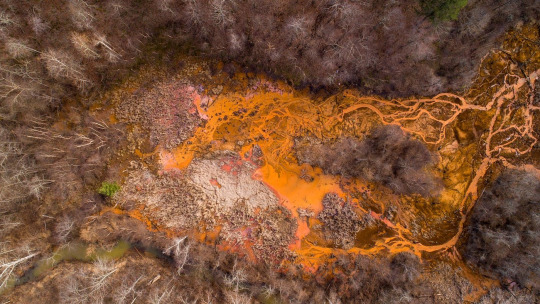
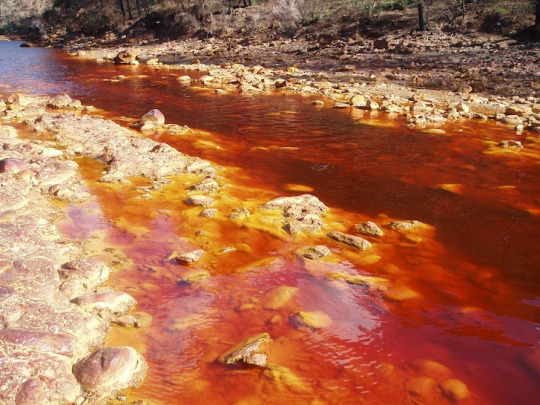
Basically they realized hey no one's cleaning this shit up, it's polluting the streams, killing all the fish, making the water undrinkable and there's a huge market for it so why not make money by cleaning it the fuck up?

They remove this stuff by the industrial bucket load from the rivers. The idea is if it's in a painting, if it's in your home, it's not poisoning wildlife.
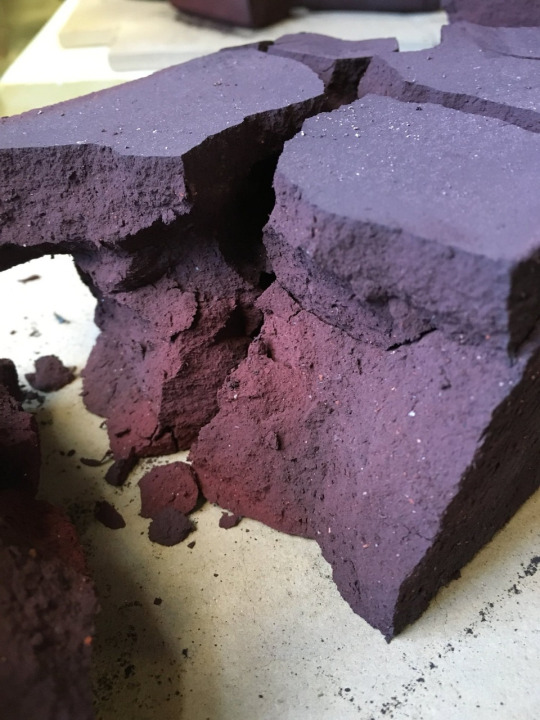

anyway its cool as shit, please support tf out of these people https://gamblinstore.com/reclaimed-earth-colors-set/
#environmental cleanup#toxic cleanup#abandoned mine program#art supplies#oil painting#pigments#the intersection of two of my worlds#I love it#When we get new site managers I test their sense of humor#by talking about the beautiful danger colors leaking out of mines#(not these but like HELLA COPPER or cobalt or cadmium)#and/or by claiming that growing up in Tacoma gave me a natural immunity to lead and arsenic#Do they laugh or get concerned?#I suppose if I'd had more childhood lead exposure I might believe that was how it worked#...imagine how smart I'd be if I hadn't had any :(
72K notes
·
View notes
Text
What is Bioremediation and its Importance in Environmental Conditions
Bioremediation is a natural, eco-friendly method that removes environmental contaminants using microorganisms and plants.It is cost-effective and sustainable, helping purify soil and water while restoring ecological balance.Though it faces challenges like slow processing, it remains a promising environmental solution.Bioremediation plays a vital role in creating a cleaner and greener planet.
Click here: https://vanamindiafoundation.org/37/blog_detail
#Bioremediation#Environmental Cleanup#Eco-Friendly Solutions#Soil Remediation#Water Purification#Microorganisms in Bioremediation#Green Technology#Sustainable Environment#Environmental Sustainability#Natural Pollution Cleanup#Phytoremediation#Microbial Remediation
0 notes
Text

When self-described “ocean custodian” Boyan Slat took the stage at TED 2025 in Vancouver this week, he showed viewers a reality many of us are already heartbreakingly familiar with: There is a lot of trash in the ocean.
“If we allow current trends to continue, the amount of plastic that’s entering the ocean is actually set to double by 2060,” Slat said in his TED Talk, which will be published online at a later date.
Plus, once plastic is in the ocean, it accumulates in “giant circular currents” called gyres, which Slat said operate a lot like the drain of the bathtub, meaning that plastic can enter these currents but cannot leave.
That’s how we get enormous build-ups like the Great Pacific Garbage Patch, a giant collection of plastic pollution in the ocean that is roughly twice the size of Texas.
As the founder and CEO of The Ocean Cleanup, Slat’s goal is to return our oceans to their original, clean state before 2040. To accomplish this, two things must be done.
First: Stop more plastic from entering the ocean. Second: Clean up the “legacy” pollution that is already out there and doesn’t go away by itself.
And Slat is well on his way.

Pictured: Kingston Harbour in Jamaica. Photo courtesy of The Ocean Cleanup Project
When Slat’s first TEDx Talk went viral in 2012, he was able to organize research teams to create the first-ever map of the Great Pacific Garbage Patch. From there, they created a technology to collect plastic from the most garbage-heavy areas in the ocean.
“We imagined a very long, u-shaped barrier … that would be pushed by wind and waves,” Slat explained in his Talk.
This barrier would act as a funnel to collect garbage and be emptied out for recycling.
But there was a problem.
“We took it out in the ocean, and deployed it, and it didn’t collect plastic,” Slat said, “which is a pretty important requirement for an ocean cleanup system.”
Soon after, this first system broke into two. But a few days later, his team was already back to the drawing board.
From here, they added vessels that would tow the system forward, allowing it to sweep a larger area and move more methodically through the water. Mesh attached to the barrier would gather plastic and guide it to a retention area, where it would be extracted and loaded onto a ship for sorting, processing, and recycling.
It worked.
“For 60 years, humanity had been putting plastic into the ocean, but from that day onwards, we were also taking it back out again,” Slat said, with a video of the technology in action playing on screen behind him.
To applause, he said: “It’s the most beautiful thing I’ve ever seen, honestly.”
Over the years, Ocean Cleanup has scaled up this cleanup barrier, now measuring almost 2.5 kilometers — or about 1.5 miles — in length. And it cleans up an area of the ocean the size of a football field every five seconds.

Pictured: The Ocean Cleanup's System 002 deployed in the Great Pacific Garbage Patch. Photo courtesy of The Ocean Cleanup
The system is designed to be safe for marine life, and once plastic is brought to land, it is recycled into new products, like sunglasses, accessories for electric vehicles, and even Coldplay’s latest vinyl record, according to Slat.
These products fund the continuation of the cleanup. The next step of the project is to use drones to target areas of the ocean that have the highest plastic concentration.
In September 2024, Ocean Cleanup predicted the Patch would be cleaned up within 10 years.
However, on April 8, Slat estimated “that this fleet of systems can clean up the Great Pacific Garbage Patch in as little as five years’ time.”
With ongoing support from MCS, a Netherlands-based Nokia company, Ocean Cleanup can quickly scale its reliable, real-time data and video communication to best target the problem.
It’s the largest ocean cleanup in history.
But what about the plastic pollution coming into the ocean through rivers across the world? Ocean Cleanup is working on that, too.
To study plastic pollution in other waterways, Ocean Cleanup attached AI cameras to bridges, measuring the flow of trash in dozens of rivers around the world, creating the first global model to predict where plastic is entering oceans.
“We discovered: Just 1% of the world’s rivers are responsible for about 80% of the plastic entering our oceans,” Slat said.
His team found that coastal cities in middle-income countries were primarily responsible, as people living in these areas have enough wealth to buy things packaged in plastic, but governments can’t afford robust waste management infrastructure.
Ocean Cleanup now tackles those 1% of rivers to capture the plastic before it reaches oceans.

Pictured: Interceptor 007 in Los Angeles. Photo courtesy of The Ocean Cleanup
“It’s not a replacement for the slow but important work that’s being done to fix a broken system upstream,” Slat said. “But we believe that tackling this 1% of rivers provides us with the only way to rapidly close the gap.”
To clean up plastic waste in rivers, Ocean Cleanup has implemented technology called “interceptors,” which include solar-powered trash collectors and mobile systems in eight countries worldwide.
In Guatemala, an interceptor captured 1.4 million kilograms (or over 3 million pounds) of trash in under two hours. Now, this kind of collection happens up to three times a week.
“All of that would have ended up in the sea,” Slat said.
Now, interceptors are being brought to 30 cities around the world, targeting waterways that bring the most trash into our oceans. GPS trackers also mimic the flow of the plastic to help strategically deploy the systems for the most impact.
“We can already stop up to one-third of all the plastic entering our oceans once these are deployed,” Slat said.
And as soon as he finished his Talk on the TED stage, Slat was told that TED’s Audacious Project would be funding the deployment of Ocean Cleanup’s efforts in those 30 cities as part of the organization’s next cohort of grantees.
While it is unclear how much support Ocean Cleanup will receive from the Audacious Project, Head of TED Chris Anderson told Slat: “We’re inspired. We’re determined in this community to raise the money you need to make that 30-city project happen.”
And Slat himself is determined to clean the oceans for good.
“For humanity to thrive, we need to be optimistic about the future,” Slat said, closing out his Talk.
“Once the oceans are clean again, it can be this example of how, through hard work and ingenuity, we can solve the big problems of our time.”
-via GoodGoodGood, April 9, 2025
#ocean#oceans#plastic#plastic pollution#ocean cleanup#ted talks#boyan slat#climate action#climate hope#hopepunk#pollution#environmental issues#environment#pacific ocean#rivers#marine life#good news#hope
9K notes
·
View notes
Text
Transforming the World through Environmental Cleanup
EcoCare is an innovative environmental cleanup service committed to restoring and preserving the natural beauty of our planet. We understand the pressing need to combat pollution, protect ecosystems, and create a sustainable future for generations to come.

0 notes
Text
youtube
#good news#environmentalism#science#ocean cleanup#save our seas#trash clean up#environment#video#pbs#wild hope#direct action#water pollution#Youtube
13 notes
·
View notes
Text
have long realized that my number one priority for a job is to not have homework. i cannot do the homework lifestyle. i need the 9-5 and when it is 5 i dont think about work until the next day type experience
#ik most jobs are like that but i grew up with my dad having unpaid overtime project management stuff and he has a salary not hourly so#he works like 70 hours a week and works on vacations etc bc hes a project manager and needs to meet company deadlines etc#and like hes a geologist doing environmental cleanup so like not the kind of job you'd expect to have that#anyways i never want that lifestyle for myself#and like rn in grad school and doing 27 hours a week at an internship i am MISERABLE#i just worked 8:30-5pm and i have about 6 hours of homework to do
23 notes
·
View notes
Text
One thing I have learned in this phd program is that somehow everything is the d*fense industry. Have u ever asked urself why we know so much about craters on the moon. I hadn’t. U will not like the answer
#and what is the guy who studied environmental cleanup doing going to a n*tional l*b…………#they don’t usually send u to the secretive place to do work that’s good PR like saving the environment. I’ll tell u that much#paying him six figures as a postdoc. oh he is not cleaning up anything I fear#(I actually don’t think he’s up to anything particularly sinister. I’m pretty sure it’s all publicly released and published stuff . but its#not as altruistic as u would hope )
3 notes
·
View notes
Text
7 notes
·
View notes
Text
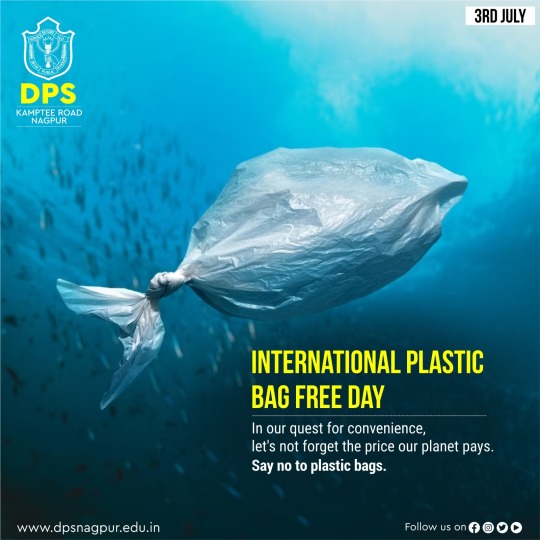
International Plastic Bag Free Day | Plastics give a helping hand, but they are polluting our land!
This day symbolizes the significance of taking small steps in refusing plastic bags, which can contribute to monumental leaps for our beautiful, clean, and green environment. By choosing reusable alternatives and raising awareness about the harmful effects of plastic bags, we empower ourselves to make a positive impact.
International Plastic Bag Free Day
DPS Kamptee Road Nagpur
#Plastic bag pollution#Single-use plastics#Environmental impact#Sustainable alternatives#Reduce plastic waste#Reusable bags#Plastic bag bans#Plastic bag recycling#Plastic bag awareness#Eco-friendly choices#Plastic bag legislation#Plastic-free living#Ocean conservation#Marine litter#Plastic bag consumption#Waste management#Green initiatives#Plastic pollution prevention#Community cleanups#Global environmental awareness
3 notes
·
View notes
Text
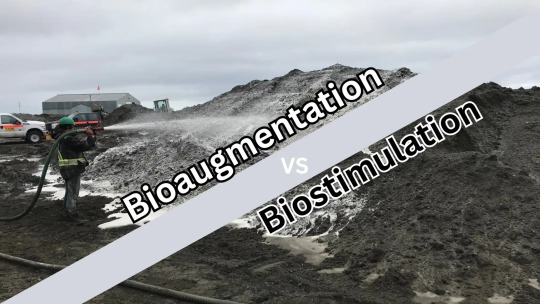
Unraveling the Depths of Bioaugmentation and Biostimulation: A Comprehensive Comparison
Introduction:
If you've ever delved into the field of environmental biotechnology, you've likely stumbled across the terms "bioaugmentation" and "biostimulation". These sophisticated approaches to environmental remediation are both aimed at enhancing natural processes to treat contamination. But what exactly distinguishes one from the other? In this article, we will delve into the specifics of Bioaugmentation vs Biostimulation, breaking down their definitions, applications, and key differences.
Understanding Bioaugmentation:
Bioaugmentation, in its simplest form, is the introduction of a group of natural microbial strains or a genetically engineered variant into an environment to enhance the rate of pollutant degradation. These microbial strains, often referred to as 'augments', are known for their specialized ability to degrade contaminants that the existing microbial community cannot effectively handle. This technique is frequently employed to address the contamination of soil and water bodies with organic pollutants such as oil spills and certain types of industrial waste.
Diving into Biostimulation:
On the other hand, biostimulation involves the stimulation of indigenous microbial communities already present in the environment by providing nutrients, electron acceptors, or substrates that enhance their activity. Unlike bioaugmentation that adds new organisms to an ecosystem, biostimulation works with the existing microbial population, encouraging their growth and pollutant degradation capabilities. Often used in environmental cleanup efforts, biostimulation can enhance the breakdown of a broad range of pollutants, including petroleum hydrocarbons and heavy metals.
Bioaugmentation Vs Biostimulation: A Comparative Study:
Now that we understand the fundamentals of both processes, it's time to compare them head-to-head.
Techniques Involved: While bioaugmentation is about introducing specific microbial strains to boost pollutant degradation, biostimulation works by providing necessary nutrients or substrates to stimulate the indigenous microbial population.
Scope of Application: Both techniques are used in environmental remediation, especially for soil and groundwater. Bioaugmentation has a slight edge in cases where specific contaminants require particular microbial strains for degradation. Biostimulation, however, is often favored for broader applications, given that it enhances the overall microbial activity and not just that of specific strains.
Economic Aspects: Bioaugmentation requires the cultivation and addition of specific microbial strains, which can be costly and technically demanding. On the contrary, biostimulation usually involves adding relatively inexpensive nutrients or substrates, making it a more economically feasible option in many cases.
Environmental Impact: Bioaugmentation involves adding new organisms, which raises concerns about the impact on the existing ecosystem and the potential for creating imbalances. Biostimulation, working with existing microbial communities, is generally viewed as having a less disruptive impact on ecosystem balance.
Effectiveness: Both techniques have proven effective in various scenarios, but their success heavily depends on site-specific conditions. For instance, bioaugmentation's effectiveness might be hindered by the inability of the added microbes to survive in the new environment. Biostimulation's success, on the other hand, could be limited by the potential growth of undesired microbial communities.
Conclusion:
Bioaugmentation and biostimulation, though conceptually distinct, share a common goal: to utilize biological processes for environmental remediation. Choosing between them demands a clear understanding of the contamination at hand, the existing microbial community, and the economic and environmental implications of each approach. As scientists continue to explore these fascinating techniques, our ability to heal the environment using nature's own tools will only continue to improve.
#Bioaugmentation#Biostimulation#Bioremediation technologies#Environmental Remediation#Pollution control methods#Bioaugmentation vs Biostimulation#Benefits of bioaugmentation#Benefits of biostimulation#Bioaugmentation in habitat restoration#Biostimulation for pollution control#Limitations of bioaugmentation#Limitations of biostimulation#Bioaugmentation-assisted biostimulation#Microbial bioremediation#Sustainable environmental practices#Choosing between bioaugmentation and biostimulation#Understanding bioaugmentation#Understanding biostimulation#Industrial waste management#Oil spill cleanup techniques
5 notes
·
View notes
Text
Michigan Pollution Law Overhaul Targets Polluters With Costly Cleanup Mandates
Michigan Senate and House Democrats introduce legislation to update cleanup rules, ensure transparency, and make polluters pay for contamination costs LANSING, Mich. — June 7, 2025 — A sweeping legislative package introduced this week by Michigan Senate and House Democrats seeks to overhaul the state’s pollution cleanup laws, shifting financial and legal responsibility onto polluters. The…
0 notes